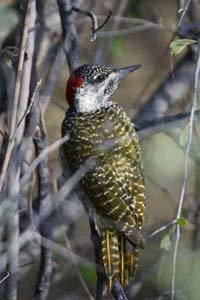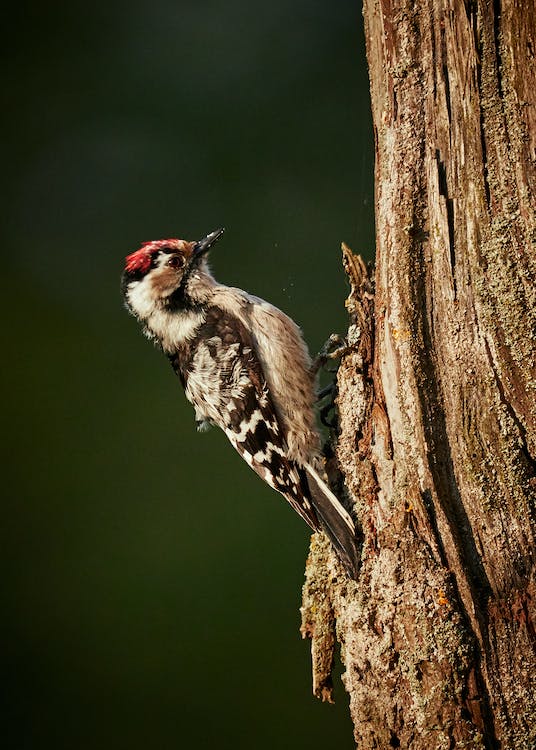The Golden-tailed Woodpecker, also known as Campethera abingoni, is a bird species categorized in the Picidae family. Also known as the Woodpecker family, it includes piculets, wrynecks, and sapsuckers. Members of this bird family can be seen across the world, except New Zealand, Madagascar, Australia, New Guinea, and polar regions. The Golden-tailed Woodpecker’s closest relatives include Ground Woodpecker, Red-crowned Woodpecker, and Ochre-collared Piculet.
Its binomial name honors Montague Bertie, the 5th Earl of Abingdon. The species was first discovered by Scottish explorer Sir Andrew Smith in 1836. The Golden-tailed Woodpecker is a member of a species complex, together with the Knysna Woodpecker and Mombasa Woodpecker, with which it was believed to hybridize with.
The Golden-tailed Woodpecker looks like the Mombasa Woodpecker, which has yellower plumage underparts, brighter golden-green upperparts, with dotted streaks and no barring.
This species is widely distributed across the African continent. Since it occurs in a wide range and their population appears to be at a stable rise, the International Union for Conservation of Nature (IUCN) Red List categorized this species as Least Concern.
Its seven levels of scientific classification are as follows:
Kingdom: Animalia
Phylum: Chordata
Class: Aves
Order: Piciformes
Family: Picidae
Genus: Campethera
Species: C. abingoni
The physical characteristics of a Golden-tailed Woodpecker
The species’ primary distinguishing characteristic is its golden tail, to where its common name came from. The blend of barred, greenish upper part plumage and streaked underparts are also distinctive. The Golden-tailed Woodpecker also has a characteristic single, strident call-note.
An adult Golden-tailed Woodpecker measures from 20 to 21 cm from its bill to the tail. Golden-tailed Woodpeckers who come from the south weigh around 70 g, whereas the northern race weighs only 55 g. Male Golden-tailed Woodpeckers are usually heavier than females. They also have different head markings—males have red and brown forecrowns, while females have black and spotted white marks. Both sexes have dark red eyes, slate grey mandibles, and greenish-olive legs and feet. Juveniles usually have heavy streaks across the throat down to the breast. They have mottled malar stripes and brown eyes.
The distribution and habitat of Golden-tailed Woodpeckers
Golden-tailed Woodpeckers primarily occurs in countries such as Angola, Botswana, Benin, Cameroon, Central African Republic, Republic of the Congo, Chad, Ghana, Gambia, Kenya, Guinea, Mozambique, Namibia, Ivory Coast, Rwanda, South Africa, Senegal, South Sudan, Tanzania, Uganda, Zimbabwe, and Zambia. They frequent a wide range of habitats, including coastal forests, miombos, mopanes, Acacia woodlands, dry shrublands, and other riparian woodlands, especially in the hotter parts of southern Africa. They are also seen in rural gardens and urban areas.
The behavior of a Golden-tailed Woodpecker
A Golden-tailed Woodpecker communicates through a loud, strident call that sounds like “waaa” or “weea.” Males usually emit this sound.
Golden-tailed Woodpeckers like exploring large branches along the lower and middle canopy while hunting for food. They often join flocks and hunt for food together. Like other Woodpeckers, they also perform drumming, a form of non-vocal communication characterized by repeatedly striking their bills on a hard surface. After a pause, the drumming is repeated. They have a specific number of beats in a roll, length of the roll, and length of the gap between the rolls and cadence. Drumming is also regarded as a territorial call, which explains why males perform drumming more frequently than females.
The egg-laying season happens between August and December, peaking from September to November. Both male and female Golden-tailed Woodpeckers excavate the nest, which is a hole on a tree branch or trunk. The female Golden-tailed Woodpecker lays 2-3 eggs, which are incubated by the male and female Golden-tailed Woodpeckers for 13 days. Both parents will take responsibility for taking care of the chicks, which will eventually leave the nest 22 to 25 days after fledging.
The diet of a Golden-tailed Woodpecker
Like other woodpeckers, Golden-tailed Woodpeckers primarily forage in trees, tapping, gleaning, and probing trees and branches for insects and invertebrates. They hammer dead or infected wood more often than other Campethera species. Their diet mostly contains termites, arboreal ants, millipedes, wood-boring larvae, mopane emperor moth larvae, and other invertebrates. They feed on these insects by licking them up using their tongue. Most of the time, they also excavate insect nests to eat them.
BOTSWANA BIRDS | SOUTH AFRICA BIRDS
NAMIBIA BIRDS | ZAMBIA BIRDS | ZIMBABWE BIRDS


